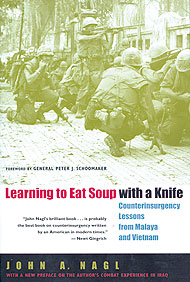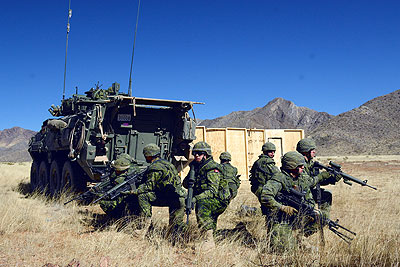 This information has been archived for reference or research purposes.
This information has been archived for reference or research purposes.
Archived Content
Information identified as archived on the Web is for reference, research or recordkeeping purposes. It has not been altered or updated after the date of archiving. Web pages that are archived on the Web are not subject to the Government of Canada Web Standards. As per the Communications Policy of the Government of Canada, you can request alternate formats on the "Contact Us" page.
Book Reviews
Learning To Eat Soup With A Knife: Counterinsurgency Lessons From Malaya And Vietnam
by John A. Nagl
Chicago: University of Chicago Press, 2002
249 pages, US $17.00 (paperback)
ISBN 978-0-226-56770-9
Reviewed by Lieutenant-Colonel Peter Williams
For more information on accessing this file, please visit our help page.
 Any book that was presented to former United States Secretary of Defense Donald Rumsfeld, as a gift by the top US military commander in Iraq as the subject of review is clearly something special. The author is a US Army officer and a veteran of the current war in Iraq, and he takes the title of his book from a quote by T.E. Lawrence (Lawrence of Arabia) who, commenting on counterinsurgency (COIN), observed: “To make war upon rebellion is messy and slow, like eating soup with a knife.” As the Canadian Forces (CF) is currently engaged in a COIN campaign in Afghanistan, this book has immediate relevance.
Any book that was presented to former United States Secretary of Defense Donald Rumsfeld, as a gift by the top US military commander in Iraq as the subject of review is clearly something special. The author is a US Army officer and a veteran of the current war in Iraq, and he takes the title of his book from a quote by T.E. Lawrence (Lawrence of Arabia) who, commenting on counterinsurgency (COIN), observed: “To make war upon rebellion is messy and slow, like eating soup with a knife.” As the Canadian Forces (CF) is currently engaged in a COIN campaign in Afghanistan, this book has immediate relevance.
Using comparisons between the British and American approaches in Malaya and Vietnam respectively, the author aims to explain “...how to build military organizations that can adapt more quickly and effectively to future changes in warfare.” In a conclusion that many may find controversial, Nagl contends that it was primarily the organizational cultural differences between the British and American armies that caused the British to be successful in Malaya, and also that led to defeat for the US in Vietnam. The author contends that the British Army was a learning organization, whereas their American counterparts were not.
The theme of “learning” forms the backbone of the book. Before getting into the details of the two COIN campaigns, Nagl devotes significant attention to discussing how armies learn. He describes what he calls the Learning Cycle, starting from individual actions and leading ultimately to changes in organizational behaviour. He further uses a series of question sets, which help first to identify whether an army is a learning organization, and, secondly, to determine whether that army was able to develop a successful COIN doctrine. He uses several examples from history to illustrate his case, including the following principles successfully applied by Mao Tse-tung’s [Zedong’s] (insurgent) Eighth Route Army:
Rules:
- All actions are subject to command
- Do not steal from the people
- Be neither selfish nor unjust
Remarks:
- Replace the door when you leave the house
- Roll up the bedding on which you have slept
- Be courteous
- Be honest in your transactions
- Return what you borrow
- Replace what you break
- Do not bathe in the presence of women
- Do not without authority search those you arrest
To anyone who has served in Afghanistan, the above principles can be equally applied to the counterinsurgent.
The core of the book involves a comparison between the two approaches taken by the British and US armies in their respective COIN campaigns. Nagl describes the culture of each army, and he determines that the British Army already had extensive experience with what he calls “Brushfire Wars,” and this proved a definite advantage in their approach to combating the Communist Terrorist (CT) threat in Malaya, from the late 1940s to the 1960s. In addition the British tended to take a decentralized small unit approach to COIN operations, which the author contrasts with the apparent preference for larger-scale US operations in Vietnam. This is not to say that the British did not have their difficulties; they certainly did, but by the time Lieutenant General Sir Harold Briggs was appointed Director of Operations in 1950, a winning formula had begun to emerge. The Briggs Plan involved a four-step process:
- Dominate the populated areas and build up a feeling of security so people are more willing to come forward with information;
- Break up the insurgents support frameworks within these areas;
- (Thus) isolating the insurgents from their food and information supply; and
- Destroy the insurgents by forcing them to attack the British and Malay forces on the counterinsurgents’ ground.
In contrast, the US Army is portrayed as an organization that was hampered in its COIN efforts by a culture that emphasized technology and firepower, and did not fully take into account political and other considerations critical in a COIN campaign. Although the US Marine Corps had much experience with “Small Wars,” and had produced a doctrinal manual on this subject in the first half of the 20th Century, it would appear that the lessons of these campaigns were not exploited fully. It may also come as a surprise to many readers to note that the British Advisory Mission (BRIAM) in Vietnam, which was in place from 1961 to 1964, and which could have facilitated the sharing of lessons between the British and US armies, was largely “ignored,” to quote Nagl. I found this quite astounding, and, to double check, I consulted the biography of General William Westmoreland (A Soldier Reports), the US commander in Vietnam, who concluded, with respect to comparisons between Malaya and Vietnam, that “...so many were the differences between the two situations that we could borrow little outright from the British experience.”1
Nagl cast his net rather wide when gathering material for this book, and the bibliography runs to an impressive 17 pages. Both British and American sources were consulted, and a number of key players in both campaigns were interviewed, including the then US Secretary of Defense, Robert McNamara, whose comments were provided for background only.
This book is highly recommended, not only for those about to deploy to Afghanistan with the CF, but also for our other Whole of Government (WoG) partners.
![]()
Lieutenant-Colonel P. J. Williams, an artillery officer, is currently serving as J5 Plans-Afghanistan, Headquarters Canadian Expeditionary Forces Command (HQ CEFCOM) in Ottawa.
Note

DND photo VL2009-0012- 097






